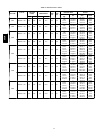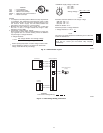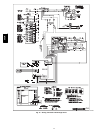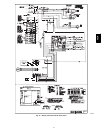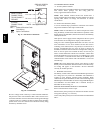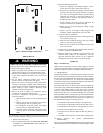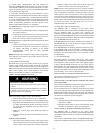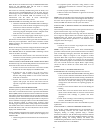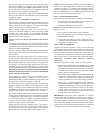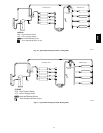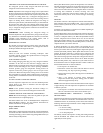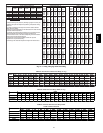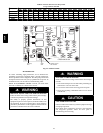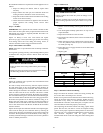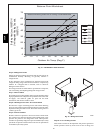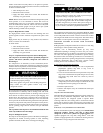
20
Check system wiring to be sure the User Interface is powered and
connectionsaremadeAtoA,BtoB,etc.,andwiringisnotshorted.
Mis-- wiring or shorting of the ABCD communications wiring will
notallow s uccessful communications.Correcting wiring faultswill
clear the code and re--establish communications.
Shortingormis--wiringthelowvoltagesystemwiringwillnotcause
damage to unit control or to User Interface but may cause the low
voltage fuseto open.
STATUS CODE 46 , BROWNOUT CONDITION
If the secondary voltage of the transformer falls below 15--vac for
a period exceeding 4 seconds,StatusCode 46 willbe displayed on
STATUS LED and t he User Interface will command the control
board to turn off Y output controlling compressor.
When secondary voltage rises above 17 --vac for more than 4
seconds, the brownout condition is cleared and normal system
operation will resume subject to any minimum compressor
off--delayfunctionwhichmaybeineffect.Brownoutdoesnotaffect
blower or electric heater operation.
STATUSCODE53,OUTDOORAIRTEMPERATURESENSOR
FAULT
IfanOAT sensorisfound atpower-- up,inputisconstantly checked
tobewithinavalidtemperaturerange.Ifsensorisfoundto beopen
or shortedat any time afterinitial validation, StatusCode 53 willbe
displayed at amber STATUS LED.
Check for faults in wiring connecting sensor to OAT terminals.
Using an Ohm meter, check resistance of thermistor for a short or
open condition.
If thermistor is shorted or open, replace it to return the system to
normaloperation.Iffaultisinthewiringconnections,correctingthe
fault will clear the codeand return thesystemto normal operation.
NOTE: If fault c ondition is an open thermistor ora wiring problem
that appears to be an open thermistor and the power to the unit is
cycled of f, the fault code will be cleared on the next power--up but
the fault will remain and system operation will not be as expected.
Thisisbecauseonpower--up,theunitcontrolcannotdiscernthe
differencebetweenan opensensororifa sensoris notinstalled.
Step 2—Sequence of Operation
The packaged heat pump is designed for installation with a
communicating User Interface. This unit will not res pond to
commandsprovided by acommon thermostatexceptundercertain
emergency situations described in Step 1—Start--Up.
The User Interface uses temperature, humidity and other data
supplied from indoor and outdoor system components to control
heating or cooling system for optimum comfort. The unit will be
commanded by User Interface to supply airflow. The unit will
operate the indoor blower at requested airflow for most modes.
The nominal requested airflow will be 350 cfm per ton of nominal
cooling capacity as defined by unit size. Actual airflow request will
be adjusted from nominal using indoor and outdoor temperature
and indoor humidity data to optimize the system operation for
occupant comfort and system efficiency. Refer to User Interface
literature for further system control details.
Airflow during electric heater operation must be greater than a
minimumlevelforsafe operation. IfUser Interface instructs unit to
turn on electric heat and the requested airflow is less than the
minimum level the unit control will override requested value.
NOTE: Once the compressor has started and then has stopped, it
should not be started again until 4 minutes have elapsed. The
cooling cycle remains “on” until the room temperature drops to
point that is slightly below the cooling control setting of the user
interface. Additionally, there is a 5--minute compressor delay built
into the control for heat pump heating mode.
Step 3—Check for Refrigerant Leaks
Locate and repair refrigerant leaks and charge the unit as follows:
1. Use both high-- and low--pressure ports to relieve system
pressure and reclaim remaining refrigerant.
2. Repair leak following accepted practices.
NOTE: Install a bi--flow filter drier whenever the system has been
opened for repair.
3. Check system for leaks using an approved method.
4. Evacuate refrigerant system and reclaim refrigerant if no
additional leaks are found.
5. Charge unit with Puron (R--410A) refrigerant, using a
volumetric--chargingcylinderoraccuratescale.Refertounit
rating plate for required charge.
Step 4—Start-- Up Adjustments
Complete the required procedures given in the Pre--Start--Up
section before starting the unit. Do not jumper any safety devices
when operating the unit. Do not operate the unit in cooling mode
when the outdoor temperature is below 40°F (unless accessory
low--ambient kit is installed). Do not rapid cycle the compressor.
Allow 5 min. between “on” cycles to prevent compressor damage.
CHECKING COOLING AND HEATING CONTROL
OPERATION
Start and check the unit for proper control operation as follows:
1. Place room UI SYSTEM switch or MODE control in OFF
position.Observethatblowermotorstartswhen FAN mode
isplaced in FAN ON position and shuts down within 60 sec
(030--060 size) or 30 sec (024 size) when FAN MODE
switch is placed in AUTO position.
2. PlacesystemswitchorMODEcontrolinHEATposition.Set
control above room temperature. Observe that compressor,
outdoor fan, and indoor blower motors start. Observe that
heating cycle shuts down when control setting is satisfied.
3. When using an automatic changeover room thermostat,
place both SYSTEM or MODE control and FAN mode
switches in AUTO positions. Observe that unit operates in
cooling mode when temperature control is set to “call for
cooling” (below room temperature), and unit operates in
heating mode when temperature control is set to “call for
heating” (above room temperature).
IMPORTANT: Three--phase, scroll compressors are direction
oriented. Unit must be checked to ensure proper compressor
3-- phase power lead orientation. If not corrected within 5 minutes,
the internal protector will shut off the compressor. The 3--phase
power leads to the unit must be reversed to correct rotation. When
turning backwards, the difference betweencompressor suction a nd
discharge pressures may be dramatically lower than normal.
50CR



